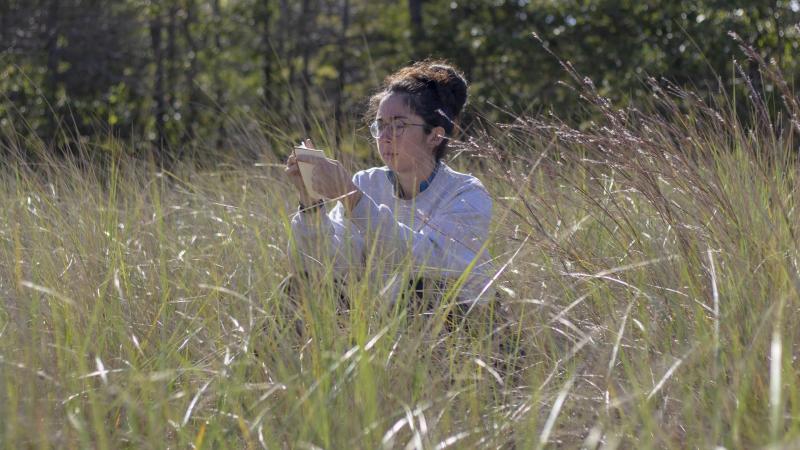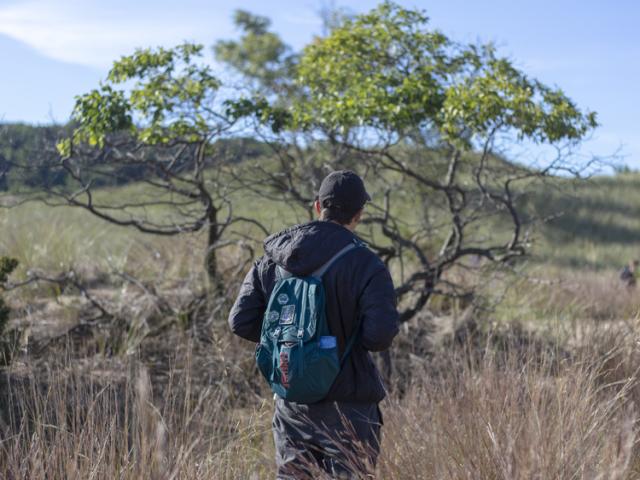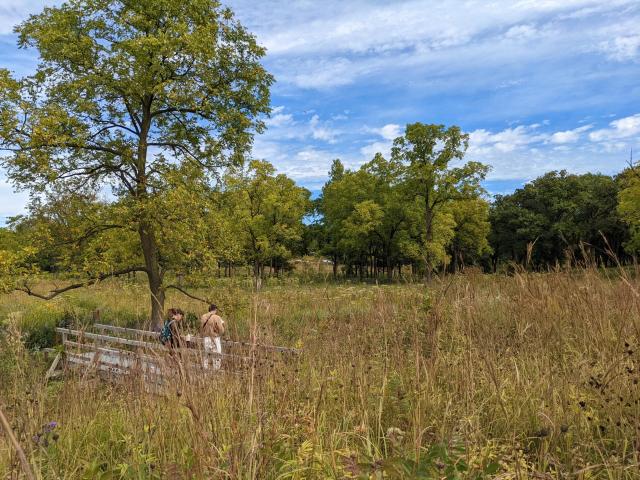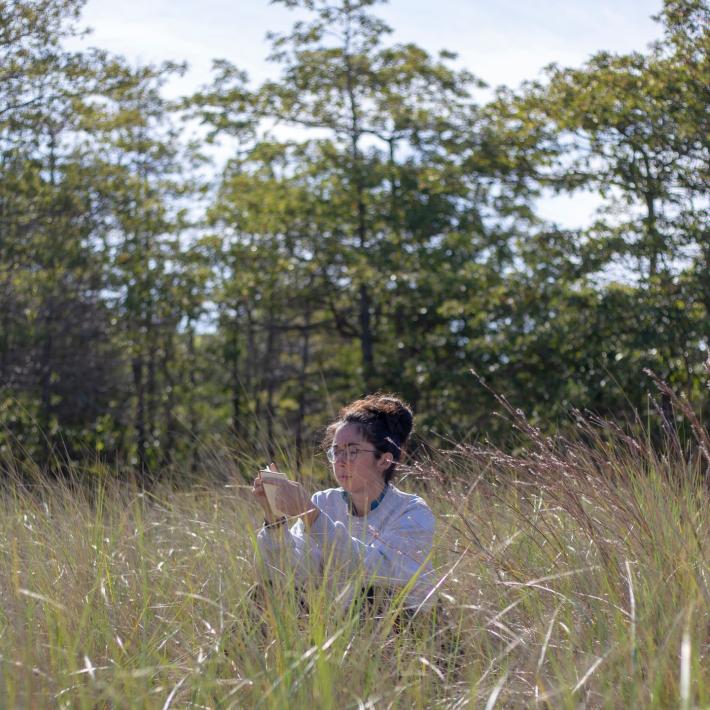MidLL: Rooting Research and Engagement in the Midwest
Midwest Landscape Lab offers students the opportunity to research distinct habitats and ecosystems of the region

MidLL: Rooting Research and Engagement in the Midwest
Through marram and sand reed grasses, a cohort of 27 graduate landscape architecture students explore the shoreline, coastal dunes, and forested areas of Saugatuck Dunes State Park. Occupying two and a half miles along Lake Michigan, the park features some of the largest freshwater dune systems in the world, and the foredune and interdunal wetlands trails reveal a wide variety of wildflowers and shrubs such as common milkweed, sand cress, bearberry, wild grape, and sand cherry to the students.
The three-day visit to the park in September of 2021 was the inaugural MidLL On Site field trip—an annual excursion to distinct habitats and ecosystems of the region. The extended outing was conducted through the Midwest Landscape Lab (MidLL), a Knowlton Landscape research and teaching initiative established in 2020 to focus on the ecological, material, and cultural forces that shape the Midwest.
MidLL’s research and educational methodologies are predicated on a ground-up approach that fosters field work and close investigation of local and regional Midwestern natural environments.
Within this pedagogical framework, the Saugatuck Dunes experience promised direct observation, experiential knowledge, and the representation of the area’s significant landscape conditions according to Associate Professor of Landscape Architecture Katherine Jenkins, who led the trip and served as the first MidLL Coordinator. “During our time at the park, students conducted drawing and sketching exercises,” said Jenkins, “but our main goal was to walk through the landscape and observe a range of ecosystems in the Midwest.”
Media Gallery







The Midwest Landscape Lab, as such, is locatable where the work and research are being conducted—in the Knowlton School, within established seed banks on the Ohio State campus, at Waterman Farm, and during instances of fieldwork within Ohio and adjacent states.
“Instead of having a static, recognizable footprint, we see the lab as a collection of moments in a landscape, which can disperse and concentrate depending on the focus of study,” said current MidLL Coordinator Brendan Ayer, expressing both the potential and unique nature of the place-based work of the lab.
MidLL (pronounced ‘middle’) is currently engaged in a number of scholarly and learning initiatives that align and often intersect with the teaching and research of the Knowlton School’s Landscape Architecture Section. What unites all MidLL activities—which range from the On Site trips to spring semester seminars and field-based research conducted by MidLL Research Fellows—is their focus on the ecological and environmental particularities and potential found in the Midwest.
Attention to native plant species and ecosystems and the various terrains that contain them is foundational to MidLL’s efforts to map a distinctly Midwestern territory for its creative and analytic engagement with the landscape and to position Midwestern ecologies within national conversations about climate change, species migration, and critical habitat.
The upcoming year will offer new opportunities to build on established projects and protocols. Plans are in place for the 2023 On Site trip to explore areas of the Appalachian highlands and plateaus. MidLL is also broadening its logistical support for the research fellows’ ongoing research. Efforts will also continue to seek a research facility—either in a permanent structure or a mobile unit—to further operationalize the work of the lab for the years to come.
During the following autumn semester, On Site immersed students in the prairie landscapes of Northern Illinois, with visits to Lurie Garden & Millennium Park, Midewin National Tallgrass Prairie, Morton Arboretum, and Garfield Park Conservatory.
“Students analyzed and captured the essence of these distinct landscapes through photography, drawing, and specimen collection,” said Ayer. “These engagements with their surroundings let students try both planned, methodical fieldwork as well as quick, instinctive action to represent and encapsulate these places over three days.”
Media Gallery





The collection, cultivation, and cataloging of distinct plant material of the Midwest is a tangible complement to these excursions. MidLL’s spring semester seminars over the past two years have grounded these longitudinal projects—and their attending methodologies—in the greenhouse and farmland soils located on the Ohio State campus. “Our goal is to collect and redistribute seeds of ecologically beneficial plants found in the Midwest,” said Ayer.
“Many of these seeds are found in specialized ecosystems of the Midwest and require specialized seasonal, soil, and moisture conditions.” Knowlton’s Landscape Architecture program is one of just two programs nationally with a seed banking program, where fieldwork and durational cultivation and maintenance are treated as critical parts of the design process.
Another outcome of this botanical stewardship is to address the common disconnect between the practice of landscape architecture and the production or cultivation of plants. “We often only consider the installed form of plants,” says Ayer. “A goal of the lab is to connect the labor of drawing and designing to the labor of producing this elemental material of landscape architecture.”
To this end, students in Jenkin’s 2022 spring semester seminar, The Meadow Project, germinated prairie purple and white clover, royal catchfly, wild bergamot, and echinacea seeds at the Howlett Greenhouse at Ohio State.
In what Jenkins called a design-build with plants, her students used assigned plots at Waterman Farm to transplant their native and non-native plants to observe their growth conditions and interactive behaviors. “With this seminar, and the lab at large, these test plots get handed down from cohort to cohort,” said Jenkins. “Students get to observe what is growing and then intervene, edit, revise, and build progressively on this ecosystem that becomes more complex every year.”
Ayer’s 2023 spring seminar, Designing a Seed Bank, studied the plant community of the Midwest oak savanna, a once prevalent but now rare ecosystem within the region. Students built on the work from Jenkins’ 2022 seminar by amending the test plots at Waterman Farm which they made use of during the spring to plant their seedlings of rare and endangered savanna species. The result is essentially an in situ seed bank at Waterman Farm according to Ayer, where MidLL cohorts can now grow and produce more seeds, and harvest them for reuse.
The MidLL Research Fellowship program, a new initiative implemented this past year, provides financial and operational support to researchers whose work aligns with the lab. In the last year, the lab has provided assistance to Michelle Arevalos Franco’s project Codifying the Bureau of Commons and Tameka Baba’s Lots of Liminality. The lab is also supporting its inaugural cohort of Field Methods Graduate Research Fellows; work by MLA students Kate Broussard, Bilwa Gulavani, and Spencer See will add to the lab’s collection of knowledge and moments in the Midwestern landscapes throughout this fall.




